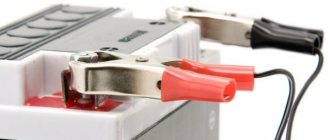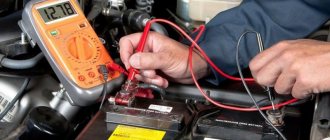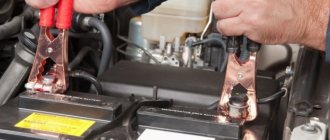How to determine the charge level
Before connecting the battery to the charger, you should make sure that the battery really needs to be charged. You can do this in five ways:
- Measure the voltage at the terminals. To do this, use a device that has a DC voltage measurement mode. This can be either an electronic multimeter or a pointer tester. If the reading is 12.7 V, there is nothing to worry about, but its decrease to the level of 12.1-12.5 V is an alarm bell about the need for recharging. 11.7 V on the device notifies the car owner that his power source is in a deep “knockout”, that is, it is completely discharged.
Multimeter
- Measure the density of the electrolyte. This method can only be used if the battery is serviceable, which means there is access to jars of electrolyte. Density is determined using a special device called a hydrometer. A charged battery has a density of at least 1.27 g/cm³. If the density is 12.2 g/cm³, then the battery is already 30% discharged.
Hydrometer
- Determine the battery charge using the indicator found in the housing of many power supplies. If it is painted green, then charging is not required; gray or white indicate the need to recharge the battery. The window, painted black, signals that the battery needs to be fully charged.
Battery charge indicator
- Using a charger, if it has a digital display. It is enough to connect it to the terminals and press a special button on the device body.
- Use a battery load fork. This method is rather professional, since not every car enthusiast has this device. Its components are: a multimeter, a load resistor and, in fact, a plug. When the latter is connected to the terminals, the operation of the starter is simulated. The device will show to what level the battery voltage drops when the engine starts. If it is 9 V, then charging is required, and if it is 10 V, everything is normal.
Load fork
The latter option is recommended to be used only on a warm battery (20-25 degrees). Otherwise, the battery can be severely drained.
Starter chargers (ROM)
There are also starting-chargers - for example, “Avtoelektrika T1014”.
How does it work? We connect it to the battery, which in turn is connected to the car’s on-board network. If the battery is “half-dead,” the charger helps start the engine. Specifically, “Autoelectric T1014” produces up to 150A for 5 seconds. When using such devices, you must carefully read the instructions! It has its own nuances and features.
Safety regulations
Everyone knows how to charge a battery, but few people think about observing safety measures, and sometimes human health depends on it. Moreover, it is not difficult to comply with them. The safety guide looks like this:
- To charge the battery, you must choose a well-ventilated place with a normal level of humidity;
- It is not recommended to smoke, work with open fire, or perform activities that generate sparks near a battery being charged from a charger;
- First, the battery is connected to the charger, and then the latter is turned on;
- The person working with the battery must wear gloves and safety glasses to protect their eyes and hands from contact with the acid solution;
- a solution of sodium carbonate or ten percent bicarbonate should be kept in close proximity.
Using the means mentioned in the last paragraph, not only the acid that comes into contact with a person is neutralized, but also particles of the reagent are removed from the body of the power source.
Battery charging features
Each type of battery has its own charging characteristics and rules of use.
This information must be provided in the operating instructions supplied with the battery products. Searching for this data is often inconvenient or there is no desire at all.
Based on this, we can highlight general rules for charging the most commonly used products.
Expert advice: after purchasing rechargeable batteries, you need to “train” them. The meaning of this is to completely discharge and charge such carriers. It is recommended to repeat this procedure 3 or 4 times.
After these manipulations, it is possible to extend the life of the batteries for a certain amount of time. This can be done by increasing the potential capacity. Thus, the so-called “memory effect” is formed, since the batteries remember their operating capacities.
Please note: if you charge batteries that are not completely drained, a so-called limit will be formed, which will cause a decrease in the physical capacity. The result of this situation will be the fragility of the devices.
It is not recommended to charge batteries at certain temperatures, namely below 5 and above 50 degrees.
The charging period cannot last several days. If you couldn’t do this after a day or a day and a half, then there is no point in continuing. There is only one way out of this situation - finding the cause of the failure. It can be not only in the charger, but also in the batteries themselves.
Expert recommendation: If the batteries are left in the charger for a long time, this will lead to overheating of the product. In order not to harm the batteries, you need to adhere to the recommended time frame.
Battery charging methods and times
Now we’ll tell you how long it takes to charge a car battery using different methods.
Direct current
Characteristics of charging a battery with direct current
The answer to the question of what current to charge the battery with is in the subheading. To do this, the current on the charger is set so that it does not exceed 1/10 of the battery capacity. So, if the battery capacity is 60 Ah, then the charging current is set at 5.5 or 6 A. Having made manual adjustment, we continue the process until the voltage at the terminals reaches a threshold of 14.4 V.
After this, the charging current is reduced to a level corresponding to 1/20 of the capacity. In our case, this is 3 A. In this way, it is possible to reduce the heating rate of the electrolyte, which means it is possible to continue the charging process.
We reduce the output current by 2 times when the voltage measured at the terminals rises to 15 V. The final stage continues until the values of both parameters stabilize: current and voltage. The final current value is maintained at 0.2 A, corresponding to the battery self-discharge mode. Duration - 8-12 hours.
At constant voltage
Characteristics of charging a battery with constant voltage
In this option, the voltage is set to the nominal charge level of 14.4 V. If a maintenance-free battery is being charged, then special attention must be paid to maintaining a certain voltage. At the same time, we should not forget about the current value, which should correspond to a level of about 10% of the capacity. If this indicator is at 20% of capacity, the battery may be damaged.
Expert opinion
Alexey Bartosh
Specialist in repair and maintenance of electrical equipment and industrial electronics.
Ask a Question
We begin recovery after a deep discharge with a voltage of no more than twelve to thirteen volts. The current value should not exceed five percent of the battery capacity. If this parameter increases, the voltage must be reduced.
It will take longer to fully charge a battery using a constant voltage than with a stable current. When setting the nominal voltage within 24 hours, you should expect a recovery of no more than 75-85%. When setting the norm at 15 V, you need to understand that over the same period the capacity will increase to ninety percent. To achieve 100% charging in 24 hours, set the voltage to 16 V or more.
However, do not forget that charging a battery with a voltage greater than 15.6 V is unsafe. If the power supply is deeply discharged, it may take about three days to bring it back into working order.
Automatic and manual charging mode
Next come the categories of chargers, the simplest of which have two technologies - automatic and manual mode.
In manual mode everything is simple. You independently evaluate the characteristics of your battery and set the charging current, which you can change during the process.
In automatic mode it is even simpler: the device constantly maintains a certain voltage (about 14.5V) and automatically reduces the current as it charges. This is the most budget segment - Katun, Orion, T1021, etc.
The next category is the charge with a constant current, for example, the Polus charger.
The device only works when the battery is connected. The charger will automatically turn off if at least one of the terminals is disconnected.
The charger stabilizes the battery charging current when the voltage of the supply network 220V, 50Hz changes. and battery charge level. This allows you to reduce the battery charging time and charge the maximum permissible current.
Available means
When studying the question of how to charge a battery, it can be noted that it is not necessary to use a special charger. It's easy to make it yourself. However, this poses a certain danger if you do not have an understanding of the basics of such a process. Moreover, not all drivers know how to charge a car battery using various available means. There are several ways to make such devices with your own hands:
- Use a standard household outlet for charging, the voltage of which is 220 volts. To do this, it is recommended to use an electronic device made of semiconductor material and technical devices capable of converting energy.
- Take a secondary power source. For example, a power supply from a laptop or computer. Such a device is capable of providing a voltage of 13–14 volts and a current of more than 1 ampere.
It should be remembered that it is necessary to constantly monitor how the car battery is charged. Proper regulation is carried out not only on the basis of periodic measurements at the battery terminals, but also on the calculation of the time interval.
Charging car batteries using improvised means requires great care, as they provoke increased heating of the battery. This in turn leads to a significant release of chemical elements such as oxygen and hydrogen. Improper use of devices can lead to dangerous situations such as damage, flames, and burns.
Smart chargers
Smart chargers - for example, from Hyundai. The processor “thinks” in them. A digital converter is installed, the processor itself decides which modes to use. These memories are for those who think and select them for some function, i.e. chose, installed and went. They have functions: specifically for gel batteries, for ordinary standard ones, power selection, fast - slow charging, etc.
Here, too, there are current restrictions - 8A, respectively, the 90th or 100th batteries will take longer to charge.
Constant voltage charging
Using this method, you can ensure the battery is charged within 90–95%.
Advantages of this method:
- instantly bringing the battery to operational mode;
- a significant portion of the electricity is used to renew the plates.
Disadvantages of this method: a significant increase in the temperature of the electrolyte due to the high current that occurs at the initial stage of charging.
It may take several days to fully charge the battery. The density of the electrolyte is the main determinant of the charge of the battery.











